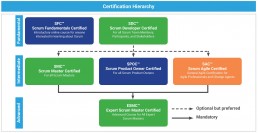Scrum
why Scrum?
- Fast, flexible, adaptive, iterative and effective, scrum is one of the most popular agile methodologies designed to deliver significant value quickly and throughout a project. Scrum ensures transparency in communication, creating an environment of collective accountability and continuous progress. The Scrum framework, as defined in the SBOK™ Guide, is structured to support product and service development in all types of industries and in any type of project, irrespective of its complexity.
- Key strengths of Scrum lies in its use of cross-functional, self-organized, and empowered teams who divide their work into short, concentrated work cycles called Sprints.
- Scrum can significantly increases ROI on projects through early Value-driven Delivery of results; providing opportunity for reinvestment and proving the worth of the project to interested stakeholders.
Scrum vs. traditional project management (PMP®, Prince2®)

Scrum principles
Scrum principles are the core guidelines for applying the Scrum framework and should mandatorily be used in all Scrum projects. They are non-negotiable and must be applied as specified in the SBOK® guide. Keeping the principles intact and using them appropriately instills confidence in the Scrum framework with regard to attaining the objectives of the project.
Scrum aspects
There are five Scrum aspects: Organisation, business justification, quality, change and risk.
why choose ScrumStudy™
ScrumStudy™ owned by VMEdu,Inc, is the biggest accreditation body for Scrum and Agile certification. As pioneers, in contrast to their competitors, they have been awarded several prominent trademarks and copyrights in the USA.
The knowledge gained by getting a SCRUMstudy™ certification is universal in its application and has been applied by organizations in diverse projects spanning an eclectic mix of industries.
SCRUMstudy™‘s certifications and courses enable delegates to scale Scrum to the Portfolio and Program levels and not just product design and project management. Each of the aspects of Product Development such as Business Justification, Quality, Cost, Risk, and Time are explained not just in the Project level but also on a Portfolio and Program level, since this is the way organizations work.
They engage with the community through active discussions on LinkedIn, Twitter, Facebook, Google Plus, multiple Discussion Forums and Blogs and various free resources are made available.
the Scrum team has three main roles:
The Srum Master (the coach), The Product Owner (who represents the business and guides the team)
and the Scrum team (the team who develops the features of the product). At the outset of your study journey, decide which will suit you best.

product owner:
- Owns the product vision and are accountable for the project outcomes
- Determines what needs to be done
- Set priorities
- Ensures that value is delivered in line with the set objectives and goals
Scrum master:
- Ensures the Scrum framework is followed
- They facilitate the process, keeping the team focused
- Their role is to focus is the process and how information is exchanged
- They remove obstacles to maximise productivity
- In addition, they guide and coach the team to ensure good team dynamics.
development team:
- They execute the project
- Self-organising, they decide on how to deliver chuncks of work at frequent intervals.
- Each have a unique set of skills but still work as a team within the project.
- Teams are small in order to remain nimble, usually 3-9 people

